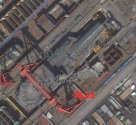Oops, yeah my mistake. It’s hard keeping track…In fact, isn't this an older image? AFAIR exactly that catapult which now is claimed to be finished was the last one one which work begun.
You are using an out of date browser. It may not display this or other websites correctly.
You should upgrade or use an alternative browser.
You should upgrade or use an alternative browser.
CV-18 Fujian/003 CATOBAR carrier thread
- Thread starter Jeff Head
- Start date
I think this picture comes from here.I don't think so. They already installing the elevator so this picture should be recent.
View attachment 81419



CV-XX (003 carrier) Thread I ... News & Discussions
Funny enough. There is a a running joke among Chinese netizens: 操导弹的心,吃火箭弹的命 That while Taiwan media constantly worry about the development of DF series missile, they should really be worried about massed PLA rocket artillery instead. nah. They are worried about the DF series because it...
www.sinodefenceforum.com
I see, my mistakeI think this picture comes from here.View attachment 81420View attachment 81421View attachment 81422CV-XX (003 carrier) Thread I ... News & Discussions
Funny enough. There is a a running joke among Chinese netizens: 操导弹的心,吃火箭弹的命 That while Taiwan media constantly worry about the development of DF series missile, they should really be worried about massed PLA rocket artillery instead. nah. They are worried about the DF series because it...www.sinodefenceforum.com
I agree with you. Also I think the submarine reactor needs to have lower self-noise.Please educate me/us the main differences of reactor for Submarine and Aircraft Carrier? I thought with a very limited space, reactor for subs is much more difficult. Of course AC also has a limited space, but much more than Subs
submarine reactors can have much lower output than full sized carrier reactors.
Lethe
Captain
So let's say you do save a billion with a conventional carrier over a 4 year production period.
My guestimate for a single SSN is $1-1.5 Billion.
But if you think the PLAN is ramping up to 3 SSNs per year anyway (we've got 2 new assembly halls at Bohai), a billion from the carrier programme over 4 years doesn't make much difference.
I do think PLAN should be ramping to produce 2-3 nuclear submarines per year, so it's good that they've invested in the facilities to do that. But I am skeptical of the budgetary side of things. I don't see how PLAN is going to accomodate massively increased spending on building and operating submarines (say, at least a fourfold increase over current spending) plus an even more dramatic increase in the budgets for carriers and naval aviation, plus maintaining high levels of spending and growth across other areas (surface combatants, amphibs and auxiliaries) that folks seem to take for granted. I don't see it working unless the plan is to increase the defence budget comparable to US levels, i.e. ~3.5% of GDP.
So far as I can see, PLAN is still very resource constrained and will remain so for the forseeable future, and in a strategic environment where peer conflict is a live possibility (as opposed to the more benign strategic environment of the previous generation) then it becomes very important to maximise return on investment in terms of delivering capabilities that can deliver victory and avert defeat. Aircraft carriers are certainly valuable, but the enormous costs required to realise a credible capability puts them towards the bottom of such RoI calculations in my view, and nuclear-powered carriers even moreso.
Last edited:
One of the space constraint on the sub is the diameter of the inner hull. For steam generator and heat exchange it is better to put them as high above the core as possible. Surface ship like a CV is naturally advantages/easier than a sub.Please educate me/us the main differences of reactor for Submarine and Aircraft Carrier? I thought with a very limited space, reactor for subs is much more difficult. Of course AC also has a limited space, but much more than Subs
I do think PLAN should be ramping to produce 2-3 nuclear submarines per year, so it's good that they've invested in the facilities to do that. But I am skeptical of the budgetary side of things. I don't see how PLAN is going to accomodate massively increased spending on building and operating submarines (say, at least a fourfold increase over current spending) plus an even more dramatic increase in the budgets for carriers and naval aviation, plus maintaining high levels of spending and growth across other areas (surface combatants, amphibs and auxiliaries) that folks seem to take for granted. I don't see it working unless the plan is to increase the defence budget comparable to US levels, i.e. ~3.5% of GDP.
So far as I can see, PLAN is still very resource constrained and will remain so for the forseeable future, and in a strategic environment where peer conflict is a live possibility (as opposed to the more benign strategic environment of the previous generation) then it becomes very important to maximise return on investment in terms of delivering capabilities that can deliver victory and avert defeat. Aircraft carriers are certainly valuable, but the enormous costs required to realise a credible capability puts them towards the bottom of such RoI calculations in my view, and nuclear-powered carriers even moreso.
I don't see as much in the way of financial constraints for nuclear submarine construction. It's more ramping up the skills, experienced workers and the supply chain.
Surface warship construction is running at a high level, but it looks lower than the average in the past 5 year planning period.
Amphibs and auxiliaries are actually fairly cheap. A Type-071 is likely $200 Million (Thai export price) and a Type-072 only $13 Million (price of the equivalent Indonesian LST). On carriers, I expect to see a measured progression and development of a mature nuclear carrier design without a mad rush to get many carriers in service quickly.
So there should be enough money to increase SSN production from 1 to 3 per year, particularly since the Chinese is still growing in excess of 5% per year.
Remember that you are advocating a saving of just $1 Billion to go with a conventional carrier design versus a nuclear one, but this would delay the development of a mature nuclear carrier design by 4+ years.
That $1 Billion is equivalent to the cost of a single Type-055, but there are already 8 launched and another 8 ordered for the current 2021-2025 period. So if you really need $1 Billion, there is actually much practical difference between having one less Type-055?
Last edited:


